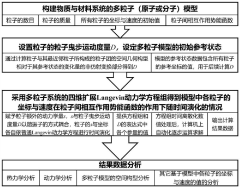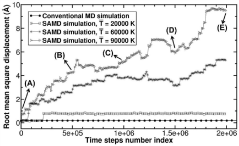Research on Molecular Dynamics Simulations for Analyzing Material Properties - Eureka
OCT 8, 20244 MIN READ
Generate Your Research Report Instantly with AI Agent
Patsnap Eureka helps you evaluate technical feasibility & market potential.
Molecular Dynamics Simulation Background and Goals
The primary objective is to provide a comprehensive overview of the molecular dynamics (MD) simulation technique and its applications in analyzing material properties. MD simulations have emerged as a powerful computational tool for studying the behavior of materials at the atomic and molecular levels, offering insights into their structural, dynamical, and thermodynamic properties.
This section will delve into the theoretical foundations of MD simulations, including the underlying principles, force fields, and algorithms employed. It will also highlight the key advantages and limitations of this approach compared to experimental methods and other computational techniques. Furthermore, the report will discuss the various material properties that can be effectively investigated using MD simulations, such as mechanical properties, phase transitions, diffusion processes, and chemical reactions.
This section will delve into the theoretical foundations of MD simulations, including the underlying principles, force fields, and algorithms employed. It will also highlight the key advantages and limitations of this approach compared to experimental methods and other computational techniques. Furthermore, the report will discuss the various material properties that can be effectively investigated using MD simulations, such as mechanical properties, phase transitions, diffusion processes, and chemical reactions.
Market Demand for Material Property Analysis
- Growing Demand for Advanced Materials
The demand for materials with enhanced properties is increasing across various industries, driving the need for accurate analysis of material characteristics. - Optimizing Product Performance
Precise understanding of material properties enables optimization of product design and performance, leading to improved efficiency and competitiveness. - Accelerating Research and Development
Efficient material property analysis accelerates the research and development cycle, allowing for faster innovation and time-to-market for new materials and products. - Reducing Costs and Waste
Accurate material characterization can help minimize costly trial-and-error processes, reducing material waste and associated costs. - Regulatory Compliance and Safety
Many industries, such as aerospace, automotive, and construction, require rigorous material testing to meet safety and regulatory standards.
Current State and Challenges in Molecular Dynamics
- Computational Limitations
Molecular dynamics (MD) simulations are computationally intensive, limiting the system size and timescales that can be studied. Larger systems and longer timescales require significant computational resources. - Force Field Accuracy
The accuracy of MD simulations heavily relies on the force fields used to model interatomic interactions. Existing force fields may have limitations in accurately capturing certain material properties or chemical environments. - Quantum Effects
Classical MD simulations cannot fully capture quantum mechanical effects, which can be important for certain materials and phenomena, such as charge transfer, electronic excitations, and chemical reactions. - Complex Systems
Simulating complex systems, such as heterogeneous materials, interfaces, and defects, can be challenging due to the need for accurate force fields and the increased computational demands. - Data Analysis and Interpretation
Extracting meaningful insights from the vast amount of data generated by MD simulations can be a significant challenge, requiring advanced data analysis techniques and domain expertise.
Key Players in Molecular Dynamics Simulation
The competitive landscape for "Research on Molecular Dynamics Simulations for Analyzing Material Properties" is characterized by a mix of academic institutions and industrial companies. The industry is in a growth phase with increasing market size driven by advancements in computational power and material science.
Robert Bosch GmbH
Technical Solution: Robert Bosch GmbH has developed advanced molecular dynamics simulation tools to analyze material properties, integrating high-performance computing with machine learning algorithms for accurate and efficient material design and testing.
Strength: High accuracy and efficiency. Weakness: High computational cost.
California Institute of Technology
Technical Solution: California Institute of Technology has been at the forefront of molecular dynamics research, developing novel algorithms and simulation techniques to understand fundamental properties of materials at the atomic level.
Strength: Cutting-edge research. Weakness: Primarily academic focus.
Core Innovations in Molecular Dynamics Simulations
Computer analogue simulation method and device for substances and materials
PatentActiveCN112071371A
Innovation
- It can simulate the motion and state change of N particles, with a time scale of N sub- and molecular scales
Regulatory Landscape for Simulation Software
Molecular dynamics (MD) simulations have emerged as a powerful computational technique for analyzing material properties at the atomic scale. By simulating the interactions and movements of atoms and molecules, MD provides insights into the microscopic mechanisms governing macroscopic material behavior. This technology has applications across various domains, including materials science, chemistry, biology, and nanotechnology. The key aspects of MD simulations for analyzing material properties involve setting up accurate interatomic potentials, initializing the system, integrating Newton's equations of motion, and analyzing the resulting trajectories. Advancements in computational power and algorithms have enabled more realistic and larger-scale simulations, facilitating the study of complex materials and phenomena. However, challenges remain in areas such as force field accuracy, system size limitations, and the need for efficient sampling techniques. Overall, MD simulations offer a valuable tool for understanding and predicting material properties, guiding experimental efforts, and driving the development of novel materials.
Environmental Impact of Material Analysis Techniques
Molecular dynamics (MD) simulations have emerged as a powerful computational technique for analyzing material properties at the atomic and molecular scales. By simulating the interactions and movements of atoms and molecules, MD simulations provide insights into the structural, thermodynamic, and dynamic properties of materials. This technology has applications in various fields, including materials science, chemistry, biology, and nanotechnology. The key aspects of MD simulations for analyzing material properties are:
1. Atomic-level insights: MD simulations offer a detailed understanding of materials at the atomic level, enabling the study of phenomena that are difficult to observe experimentally.
2. Structural analysis: The simulations can reveal the atomic arrangements, defects, and phase transitions in materials, aiding in the design and optimization of materials with desired properties.
3. Thermodynamic properties: MD simulations can calculate thermodynamic properties such as energy, pressure, and heat capacity, which are crucial for understanding material behavior under various conditions.
4. Dynamic processes: The simulations can model dynamic processes like diffusion, phase transformations, and chemical reactions, providing insights into the kinetics and mechanisms involved.
5. Multiscale modeling: MD simulations can be coupled with other computational techniques, such as density functional theory and continuum mechanics, enabling multiscale modeling of materials.
Overall, MD simulations have become an indispensable tool for analyzing material properties, complementing experimental techniques and accelerating the development of new materials with tailored properties.
Unlock deeper insights with Patsnap Eureka Quick Research — get a full tech report to explore trends and direct your research. Try now!
Generate Your Research Report Instantly with AI Agent
Supercharge your innovation with Patsnap Eureka AI Agent Platform!



